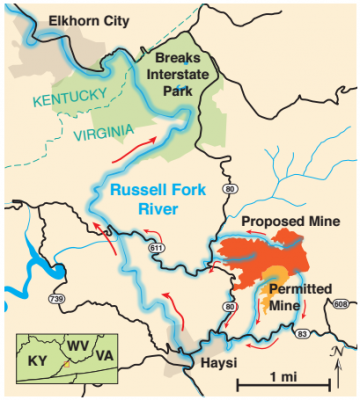Front Porch Blog

A map of the Doe Branch Mine and watershed connections to the Russell Fork River. At a recent hearings Southwest Virginians shared their concerns about Doe Branch with state regulators.
“God gave us the water so we can stay clean, and so we can drink it. I don’t want poison in the water.”
Those are the words of 6-year-old Levi Marney, spoken on the evening of Nov. 7, to representatives of the Virginia Department of Mines, Minerals and Energy (DMME) at a public meeting about the proposed Doe Branch mountaintop removal mine in Haysi. The mine, proposed by Contura Energy, would raze over 1,100 acres near young Levi’s home and discharge sediment and other mining-related pollutants into the Russell Prater Creek where children like Levi and his siblings play during the warm months.
Levi was the first of 10 individuals to speak that night. As he sat down, his grandmother Gail stood up, and with a hand on Levi’s shoulder said, “I’m here to speak against this mine for five reasons and this is one of them. He is one of my five grandchildren. He’s the seventh generation of our family on our property in Dickenson County. Many members of our family are in coal mining, but we know the future of Dickenson County is in tourism, and it’s in taking care of our environment better than we have in the past.”
The particular matter under question at this public meeting — called an “informal conference” by the state — was a renewal of the operation’s National Pollution Discharge Elimination System (NPDES) permit. The NPDES permitting process is the method by which point sources of pollution are monitored and legally allowed to release various pollutants into public waterways like the Russell Prater Creek and the Russell Fork River. The DMME approved the initial NPDES permit for the Doe Branch mine back in 2012. But, as several individuals who spoke out at the informal conference pointed out, the U.S. Environmental Protection Agency has maintained an objection to the project from its outset, citing the likelihood that the mine would cause further harm to the Russell Prater Creek, which is already listed by the state of Virginia as being impaired by mining-related pollution.
In addition to concerns over water quality, many individuals spoke to the urgent need to develop new economic opportunities that utilize exactly the natural assets that large-scale surface mining destroys. Underscoring her opposition to the Doe Branch project, Sister Jackie Hanrahan, a nun representing the Appalachian Faith and Ecology Center in neighboring Wise County said, “A healthy economy can only happen when we have a healthy ecosystem. We’ve focused on only extractive industries for so long, but now we’re finally at a point where we have people working together over different philosophies to build a healthy economy.”
The Doe Branch mine has already received the other permits it needs to move forward. The EPA objection is one of the only things currently preventing the mine from moving forward. Cooperation between state and federal agencies in making permitting decisions is an intentional system that creates checks and balances in weighing factors that impact industries, communities and the environment. That’s exactly what is happening with the Doe Branch permit. But it could change quickly under a Trump presidency.
While many personnel will remain at the EPA, changes in high-level staff, budget, or regulations could alter how the agency handles permitting decisions for mountaintop removal coal mining. Market forces are another largely independent factor. There is no magic wand that can suddenly put more coal in the ground, or make the coal that remains more economically feasible to mine and burn in the face of stiff market competition from natural gas and increasingly competitive renewable energy sources. In light of this reality, it is difficult to gauge how eager Contura Energy is to begin work on an operation of this size.
PREVIOUS
NEXT

Leave a comment
Your email address will not be published. Required fields are marked *

Leave a Comment